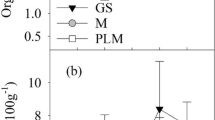Abstract
The effects of mulching with perforated black plastic, in combination with fertilization and induced mycorrhizal symbioses, on the growth of loblolly pine (Pinus taeda L.) and yellow-poplar (Liriodendron tulipifera L.) were studied in a plantation under intensive, short rotation management. Mulching effects on soil temperature were also examined in order to assess the potential influence of this treatment on temperature-dependent processes in soils affecting tree growth. Mulching significantly increased height and stem diameter growth of both species, attributable largely to improved water relations resulting from diminished soil surface evaporation and elimination of transpirational losses from competing vegetation. Mulching effects on soil temperature were insufficient to contribute substantially to the growth response exhibited by mulched trees. Multiple applications of urea-N promoted enhanced growth in both loblolly pine and yellow-poplar, an effect accentuated by mulching, but the field performance of trees inoculated in the nursery with selected mycorrhizal fungi was poor relative to that of the other treatments investigated.
Similar content being viewed by others
References
Albers, D.J. and S.B. Carpenter. 1979. Influence of site, environmental conditions, mulching, and herbaceous ground cover on survival, growth, and water relations of European alder seedlings planted on surface mine spoil. In: Carpenter, S.B. and R.W. De Vore (Eds) Proceedings of the Symposium on Surface Mining Hydrology, Sedimentology, and Reclamation, University of Kentucky, Lexington, December 4–7, pp. 23–32. Office of Engineering Services Publications, University of Kentucky. 353 p.
Bengtson, G.W. 1969. Plastic strip mulch enhances response of slash pine to fertilization on sandhills site. Tree Planter's Notes 20(3): 1–6.
Black, A.L. and B.W.Greb. 1962. Nitrate accumulation in soils covered with plastic mulch. Agron. J. 54: 366.
Bowersox, T.W. and W.W.Ward. 1970. Black polyethylene mulch—an alternative to mechanical cultivation for establishing hybrid poplars. Tree Planters' Notes 21(1): 21–24.
Braunstein, H.M., P.Kanciruk, R.D.Roop, F.E.Sharples, J.S.Tatum and K.M.Oakes. 1981. Biomass energy systems and the environment. Pergamon Press, New York. 182 p.
Clarkson, V.A. 1960. Effect of black polyethylene mulch on soil and microclimate temperature and nitrate level. Agron. J. 52: 307–309.
De Byle, N.V. 1969. Black polyethylene mulch increases survival and growth of a Jeffrey pine plantation. Tree Planters' Notes 19(4): 7–11.
Flint, L.E. and S.W.Childs. 1987. Effect of shading, mulching and vegetation control on Douglas-fir seedling growth and soil water supply. Forest Ecol. Manage. 18: 189–203.
Hermann, R.K. 1967. Paper mulch helps ponderosa pine seedlings get started on dry sites in Oregon. Tree Planters' Notes 18(4): 14–15.
Kormanik, P.P., W.C.Bryan and R.C.Schultz. 1980a. Increasing endomycorrhizal fungus inoculum in forest nursery soil with cover crops. South. J. Appl. For. 4: 151–153.
Kormanik, P.P., W.C.Bryan and R.C.Schultz. 1980b. Procedures and equipment for staining large numbers of plant root samples for endomycorrhizal assay. Can. J. Microbiol. 26: 536–538.
Loewenstein, H. and F.H.Pitkin. 1970. Ponderosa pine transplants aided by black plastic mulch in Idaho plantation. Tree Planters' Notes 21(4): 23–24.
Marx, D.H. and W.C.Bryan. 1975. Growth and ectomycorrhizal development of loblolly pine seedlings in fumigated soil infested with the fungal symbiont Pisolithus tinctorius. Forest Sci. 21: 245–254.
Marx, D.H., W.C.Bryan and C.E.Cordell. 1976. Growth and ectomycorrhizal development of pine seedlings in nursery soils infested with the fungal symbiont Pisolithus tinctorius. Forest Sci. 22: 91–100.
Marx, D.H., W.C.Bryan and C.E.Cordell. 1977. Survival and growth of pine seedlings with Pisolithus ectomycorrhizae after two years on reforestation sites in North Carolina and Florida. Forest Sci. 23: 363–373.
Rietveld, W.J. and L.J. Heidmann. 1974. Mulching planted ponderosa pine seedlings in Arizona gives mixed results. USDA Forest Serv., Rocky Mt. Forest and Range Exp. Stn. Res. Note RM-257. 3 p.
Ursic, S.J. 1966. Mulch improves loblolly pine survival on coastal plain parent materials. J. For. 64: 728–730.
Waggoner P.E., P.M. Miller and H.C. De Roo. 1960. Plastic mulching: principles and benefits. Connecticut Agric. Exp. Stn. Bull. 634. 44 p.
Wakeley P.C. 1954. Planting the southern pines. USDA Forest Serv. Agric. Monogr. 18. 233 p.
Walker, L.C. 1961. Black plastic “mulch” for pine planting. Tree Planters' Notes No. 45, p. 1.
Walker, R.F., R.J.Luxmoore and S.B.McLaughlin. 1985a. Mulching improves the growth and internal moisture status of loblolly pine and yellow-poplar in an intensively managed biomass plantation. In: Shoulders, E. (Ed) Proceedings of the Third Biennial Southern Silvicultural Research Conference, Atlanta, GA, November 7–8, 1984, pp. 315–320. USDA Forest Serv., South. Forest Exp. Stn. Gen. Tech. Rep. SO-54. 589 p.
Walker, R.F., D.C.West, S.B.McLaughlin and C.C.Amundsen. 1985b. The performance of loblolly, Virginia, and shortleaf pine on a reclaimed surface mine as affected by Pisolithus tinctorius ectomycorrhizae and fertilization. In: Shoulders, E. (Ed) Proceedings of the Third Biennial Southern Silvicultural Research Conference, Atlanta, GA, November 7–8, 1984, pp. 410–416. USDA Forest Serv., South. Forest Exp. Stn. Gen. Tech. Rep. SO-54. 589 p.
Author information
Authors and Affiliations
Rights and permissions
About this article
Cite this article
Walker, R.F., Mclaughlin, S.B. Black polyethylene mulch improves growth of plantation-grown loblolly pine and yellow-poplar. New Forest 3, 265–274 (1989). https://doi.org/10.1007/BF00028934
Received:
Accepted:
Issue Date:
DOI: https://doi.org/10.1007/BF00028934




